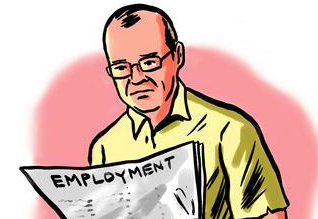Continued from: Un-employment; under-employment; and the plain unvarnished truth
.
.
Additional to my original blogpost on The Daily Blog on 6 February.
In up-coming unemployment stats, I’ll be focusing on the Jobless and under-employed numbers, as well as the narrower “unemployed” stats from the Household Labour Force Survey (HLFS). It is evident from the numbers of under-employed and the extremely narrow defining on what constitutes an unemployed person, that we are not getting the full picture from the HLFS.
Coupled to that, the Census last year revealed unemployment to be at an astonishing 7.1% whilst Roy Morgan poll (5 December 2013) had the figure at 8.5%.
By comparison, the HLFS (at roughly the same time) had unemployment at 6.2%.
So unemployment stats ranged from 6.2% (HLFS) to 8.5% (Roy Morgan).
Coupled to that is the narrow definition of the HLFS used by Statistics NZ (see below), and we begin to see why the “official unemployment rate” appears more ‘benign’.
From the January 2014 Parliamentary report, Unemployment and employment statistics: the Household Labour Force Survey in context;
The Reserve Bank has expressed concern at its variance with other indicators. [2] A commentator in the Westpac Bulletin, puzzled by the continued weakness of the HLFS in 2012 compared to the Quarterly Employment Survey (QES) and other labour market indicators, described it as ‘confusion reigns’ and suggested that survey ‘volatility’ played a role. [3] The ANZ commentator is cautious: ‘The HLFS has been very volatile in recent years, and we and the Reserve Bank will treat the result with a degree of scepticism, preferring to take note of a wide range of labour market indicators.’ [4]
These broader labour market indicators include external ones such as business and consumer surveys and job advertisements. These are in addition to those derived from official statistics such as changes in the employment and labour force participation rates, full- and part-time work, and hours worked, together with fine-grained analysis of changes by region, industry and age.
Various reasons for the volatility of the unemployment rate and its variance with other labour market indicators have been discussed – the impact of the recession, the dynamic nature of the labour market, the survey nature of the HLFS, and differences in coverage of the statistics. It has been suggested that the HLFS is more volatile at a turning point – either going into or out of recession…
The latest Household Labour Force Survey (HLFS) stats;
Officially unemployed stats;
The unemployment rate decreased over the quarter, down 0.2 percentage points to 6.0 percent. This decrease reflected 2,000 fewer people being unemployed [147,000]. The fall in unemployment was from fewer men unemployed.
Official unemployment: down
The under-employment stats;
Over the year, the total number of under-employed people increased by 27,200 to 122,600. As a result, the under-employment rate increased 1.0 percentage points to 5.3 percent.
Official under-employment: up
The HLFS Jobless stats;
In the year to December 2013, the number of people in the jobless category fell 27,400 to 257,100. Alongside the 15,000 fall in the number of people unemployed, there was also a 10,200 fall in the number of people without a job who were available for work but not actively seeking.
Official Jobless: down
Observation #1: Under-employment is increasing, which brings into question how effective the “drop” in unemployment and Jobless actually is. As being “employed” is defined as working for one hour (or more) per week; with or without pay: the whole statistical reporting of true unemployment in New Zealand is now called into question. Especially with regards to the next point.
Observation #2: “A 10,200 fall in the number of people without a job who were available for work but not actively seeking” signifies that the drop in Unemployment/Jobless can also be attributed to people giving up, as this Radio NZ report stated in February last year (2013).
Observation #3: As stated in the “Definitions” below, a person who is job seeking only through newspapers is not considered in the “Unemployed” category, but under the wider “Jobless” definition. Considering that a number of households cannot afford the internet, and do not qualify for WINZ registration, this makes a sizeable “chunk” of unemployed effectively invisible.
Observation #4: The above Observation suits successive governments, which are desperate to report lower unemployed so as to gain support from voters.
Definitions
Jobless: people who are either officially unemployed, available but not seeking work, or actively seeking but not available for work. The ‘available but not seeking work’ category is made up of the ‘seeking through newspaper only’, ‘discouraged’, and ‘other’ categories.
Under-employment: employed people who work part time (ie usually work less than 30 hours in all jobs) and are willing and available to work more hours than they usually do.
Employed: people in the working-age population who, during the reference week, did one of the following:
-
worked for one hour or more for pay or profit in the context of an employee/employer relationship or self-employment
-
worked without pay for one hour or more in work which contributed directly to the operation of a farm, business, or professional practice owned or operated by a relative
-
had a job but were not at work due to: own illness or injury, personal or family responsibilities, bad weather or mechanical breakdown, direct involvement in an industrial dispute, or leave or holiday.
Up-coming unemployment stats will focus on Jobless and under-employed numbers, as well as the more restrictive “unemployed” stats from the HLFS. Hopefully this will create a more comprehensive ‘snapshot’ of what is happening in the jobs ‘market’.
.
*
.
References
NZ Parliament: Unemployment and employment statistics: the Household Labour Force Survey in context
Roy Morgan: New Zealand real unemployment steady at 8.5% and a further 11.3% (up 2.7%) of workforce are under-employed
Roy Morgan: Roy Morgan measures real unemployment in Australia not the “perception” of unemployment
Statistics NZ: 2013 Census QuickStats about national highlights
Statistics NZ: Household Labour Force Survey: September 2013 quarter
Statistics NZ: Household Labour Force Survey: December 2013 quarter
Statistics NZ: Definitions – About the Household Labour Force Survey
Radio NZ: Unemployment rate falls as more give up job hunt
Previous related blogpost
The REAL level of unemployment
Roy Morgan Poll: Unemployment and Under-employment up in New Zealand!
.
*
.
Above image acknowledgment: Francis Owen
.
.
= fs =








Another up-date;
“4 out of 5 New Zealand homes had access to the Internet, up 5 percent since 2009.”
– http://www.stats.govt.nz/browse_for_stats/industry_sectors/information_technology_and_communications/HouseholdUseofICT_HOTP2012.aspx
The corollary to that is that one in five households – a staggering 20%! – do not have internet access.
Which means that job seekers on little or no income (especially if they do not qualify for WINZ support) may rely solely on newspapers to look for jobs.
But as I’ve reported above, using a newspaper to be job-seeking does not quality you as “unemployed”.
20%.
That’s quite a number.
No wonder of official unemployment stats are dodgy as hell.
You’re only going to fool some of the people some of the time with that line Frank. The unemployment data has been consistent since the mid 1980’s. How do you know the 20% without internet are even looking for work?
Intrinsic, what you are failing to understand is that the number of part-time and casual jobs has vastly increased since unemployment records began in 1980.
6.2% unemployment in the 80’s would have meant the vast majority of employed were working fulltime jobs.
6.2% unemployment in the here and now wont be comparable at all because a significant number may be working part-time jobs.
Part time work may or may not have increased dramatically as you suggest. It would be useful to provide data to look at. Do you have that? I would also suspect that it follows trends in other nations so it would also be useful to see that.
Indeed, Sam. As I pointed out above,
“Over the year, the total number of under-employed people increased by 27,200 to 122,600. As a result, the under-employment rate increased 1.0 percentage points to 5.3 percent.”
This gives a fairly good indication what is happening with jobs; further casualisation and fragmentation.
Well that’s an assumption for which you have not provided any evidence.
@ IV – How do you know they’re not?
And no, the “unemployment data has not been consistent since the mid 1980s”.
Try again. This time with facts and source.
Hmmm, I just noticed, Intrincvalue – you’re actually following me to every blogpost I make here.
Stalking me, are you?
Well, well, well… I’ve finally managed to get up someone’s nose… 😀
Classic troll behaviour Frank. BTW IV asks “How do you know the 20% without internet are even looking for work?”.
How does IV know they AREN’T? If you can’t even afford the Internet, most of us would be desperate to get a job – I would have thought. Maybe too logical for IV.
“If you can’t even afford the Internet, most of us would be desperate to get a job – I would have thought.”
How do you know it is only people who can’t afford the internet who don’t have it? So many assumptions, so little evidence.
Perhaps you should look at the number of elderly who choose not to have internet access. How many of the 1 in 5 are within that category?
…don’t flatter yourself Frank. There is all manner of rubbish you post I could have commented on, but chose to spend time across more posts than you inhabit.
Oh, I think it’s obvious you’re focused on me… 😉
…not particularly, although in highlighting the nonsense spouted by some on the left you do seem to pop up more than most.
You’re the one making the wild assertions Frank, now I’m holding you accountable. Show us your evidence that the 1 in 5 are actually unemployed, are actually looking for work. If you can’t, your assertion is meaningless.
Here’s another point…
According to http://www.nzherald.co.nz/nz/news/article.cfm?c_id=1&objectid=11160785, 92% of kiwi’s use the internet. Much as this may come as a surprise to you, internet in the home is not the only way to access it!
Further to my other comments below…I encourage you to read http://www.aut.ac.nz/__data/assets/pdf_file/0007/424816/wipnz2013final.pdf.
The report includes a section that deals specifically with non-users, and the results show that only 7% of all non-users put their non-use down to financial considerations. 7%.
…more…
> only 8% of people were ‘non users’ or ‘ex users’. So the number of people who didn’t access the internet because of financial considerations (whether unemployed or not) was 7% of 8%, or about .5% of the total.
Interesting. I had no idea that the definition employment was working only one hour a week! And unpaid at that!! Crazy!
Yep Thats Paula bennett for you.
Thats why the unemployed numbers dropped in 2012 because she changed the definitions.
No, the definition didn’t change. The methodology has been in use since the 1980’s.
It just means the stats have been inaccurate ever since.
Especially when the last three Census report unemployment even higher than the HLFS.
But don’t let facts get in the way of your right wing delusions, eh? *rolls eyes*
Anyone searching for work knows the reality of the job market.
I’ve commonly found, upon asking the employer, that the number of applicants is usually over 50 per job, that’s any fulltime job.
Unemployment, and under employment, drives down wages and disempowers unions.
Any political party that do not aim for full employment should not be voted for. They will simply be unable to create a better society. Full employment is a fundamental requirement for an egalitarian society. Anyone who tells you otherwise is trying to shaft you, or they don’t understand how capitalism and unemployment intersect.
Comments are closed.